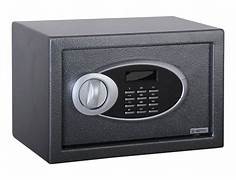Electronic Safe Lockers
An electronic safe is a secure storage device that utilizes electronic components to restrict access to its contents. These safes are typically used to shield valuable items, documents, cash, and other sensitive materials. Here are the primary components and features found in an electronic safe:
Keypad: The main interface for accessing the safe is through a digital keypad. Users input a predefined PIN code or password to unlock the safe. Some safes may also feature a touchpad or biometric fingerprint reader for added security.
Locking Mechanism: Electronic safes use an electronic locking mechanism, which is usually a motorized bolt or latch that secures the safe's door when locked. When the correct PIN is entered, the locking mechanism disengages, allowing the safe to be opened.
Override Key: To ensure access in case of a forgotten PIN or keypad malfunction, electronic safes often come with an override key. These physical keys allow authorized personnel to open the safe manually.
Battery Compartment: Electronic safes are typically powered by batteries, which are located in a separate compartment within the safe. This design ensures that the safe remains functional even during power outages.
Security Features: Electronic safes may include security features such as incorrect PIN lockout, where the safe temporarily locks out users after a certain number of failed attempts to prevent unauthorized access.
Alarm System: Some electronic safes have built-in alarm systems that trigger if someone tries to tamper with the safe, move it, or enter incorrect codes repeatedly. The alarms serve as a deterrent to potential intruders.
Mounting Options: Many electronic safes come with pre-drilled holes in their base or back, allowing for secure mounting to walls or floors. This prevents thieves from easily stealing the entire safe.
Size and Capacity: Electronic safes come in various sizes and capacities to suit different needs. Some safes are designed for personal use, while others are larger and more robust, suitable for businesses or commercial settings.
Fire and Water Resistance: High-end electronic safes may offer additional features like fire and water resistance, protecting the contents from damage in case of emergencies.
Audit Trail: In commercial settings or high-security environments, electronic safes may include an audit trail feature that records each access attempt, providing a record of who accessed the safe and when.
It's important to note that the features and capabilities of electronic safes can vary significantly between different models and manufacturers. When selecting an electronic safe system, consider the intended use, the level of security required, and any specific features that may be essential for your needs.

